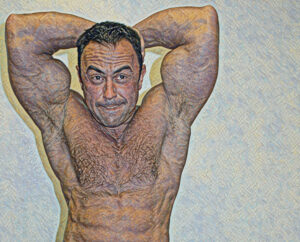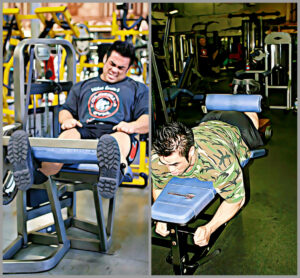Strength Sensei 101: Exercise Selection

Part 2: Sports Performance
Insights into the pioneering training methods of Charles R. Poliquin
The previous article in this series focused on what exercises to perform for physique transformation, particularly gaining muscle and losing bodyfat. This article will focus on his approach to selecting exercises for sports performance.
It’s important to consider that a workout focusing on bodybuilding or fat loss protocols may, at times, be the preferred method of training for an athlete. A sprinter with a high bodyfat percentage could see remarkable gains in speed by getting leaner. Likewise, an offensive lineman who is underweight for his position may improve their blocking ability by adding muscle.
Next, it’s important to recognize that the concept of sports specificity in the weightroom is controversial. Trying to duplicate the exact motions in a sport can be counterproductive. Consider a tennis player who takes up racquetball in the off-season. The specific hitting motion is different from tennis because the racquet head is closer to the hand. In roller skating, the gliding motion of a roller skate is much different from that of an ice skate. While at a low level a hockey player performing roller blading may be found for endurance training, it is undesirable for a high-level player, as the skating motions are so different.
That said, specificity of strength training is only reached in a few sports, such as gymnastics, weightlifting, powerlifting, and strongman competition. [Deschenes, M. Short Review: Rate Coding and Motor Unit Recruitment Patterns. Journal of Applied Sports Science Research. 1989, 3(2): pp 33-39.]
When training athletes, the Strength Sensei would begin by determining which muscles are most important to performing the sport. Writing in a sports journal over two decades ago, he cited examples of alpine skiing, diving, gymnastics, and archery. He said whereas the focus on the first two sports should be on the lower body, the focus on the second two should be on the upper body.
From here, the next step was to determine which muscles are antagonistic (have an opposing line of pull) to the primary muscles used in the sport. This was essential to prevent muscle imbalances and body alignment that would predispose the athlete to injury, including overuse injuries, such as tendinitis.
Strength Sensei said that compound exercises, such as squats, should be emphasized with athletes because they train various muscle groups simultaneously, reducing the probability of muscular imbalances. He supported his opinion with a 1988 study in which the authors said the following about the relationship between hamstring and quadriceps strength and knee stability:
“We concluded that coactivation of the antagonist is necessary to aid the ligaments in maintaining joint stability, equalizing the articular surface pressure distribution, and regulating the joint’s mechanical impedance. The reduced coactivation pattern of the unexercised antagonist to a hypertrophied muscle increases the risk of ligamentous damage, as well as demonstrates the adaptive properties of the antagonist muscle in response to exercise. It was also concluded that reduced risk of knee injuries in high performance athletes with muscular imbalance could result from complementary resistive exercise of the antagonist muscle.” [Baratta, R., Solomonow, M., Zhoud, B.H., Letson, D., Chuinard, R., and D’Ambrosia, R. Muscular Coactivation. The Role of the Antagonist Musculature in Maintaining Knee Stability. American Journal of Sports Medicine. 1988, Mar-Apr; 16(2):pp 113-22.]
 Balance between opposing muscle groups improves joint stability, reducing the risk of injury. (Miloš Šarčev photo)
Balance between opposing muscle groups improves joint stability, reducing the risk of injury. (Miloš Šarčev photo)
The next step influencing program design is to determine which muscles act as stabilizers in an athlete’s sport. The Strength Sensei found that most weakness occurred in small stabilizing muscles. He would identify these muscles and prescribe specific exercises to correct the imbalance. He used an example from gymnastics in which an athlete excels at chin-ups and dips but cannot perform the Auszug movement on the rings. He said this problem can often be traced to weakness in the muscles that internally rotator the shoulders.
The importance of the stabilizing muscles is one reason the Strength Sensei preferred free weight exercises over machines in his workouts for athletes. He said that movement pattern of a machine is not directed by the trainee, reducing the stress of stabilizing muscles. Further, he said weak stabilizers will shut down the neural output in the prime movers, reducing the muscles ability to produce force.
Along with stabilizing muscles, it’s important not to neglect relatively small muscle groups that assist in the movement of the prime movers that may impact performance, including the toe and finger flexors. The Strength Sensei supported his opinion with research showing the importance of the toe flexors to improve 40-yard dash results. [Adams, T.B., Bangerter, B.L., and Roundy, E.S.. Effect of Toe and Wrist Finger Flexor Strength Training on Athletic Performance. Journal of Applied Sports Science Research. 1988, 2(2): pp 31-24.]
After establishing these basic program design principles, the Strength Sensei provided these eight guidelines for exercise selection:
- During the preparation period, only one exercise per muscle group should be prescribed. This guideline also applies to the training of recreational athletes.
- Low-velocity training is best reserved for conventional equipment. For example, a barbell or a trap bar/hex bar is a good tool for deadlifts.
- Strength training can be gained faster by varying the intensity and volume of the workouts. However, other loading parameters much be changed for optimal progress. [Sale, D.G. Neural Adaptations to Resistance Training. Medicine and Science in Sports and Exercise. 1988, 20(5), pp S135-S145.]
- Variety in strength training can be achieved with various training implements (such as barbells, dumbbells, and a trap bar) or by changing the starting positions of an exercise. On this topic, the Strength Sensei cited to the work of John Garhammer, Ph.D., and his observations on the training methods of weightlifters. [Garhammer, J. Equipment for the Development of Athletic Strength and Power. National Strength and Conditioning Association Journal. 1981, Vol. 3, pp 24-26.]
- Variety in strength training can be achieved by changing the diameter of the grip. In the Strength Sensei’s early writings, the thick-grip implements were not common as they are today. Thus, he recommended using tape, foam, and even plastic pipes to change grip diameter.
- To focus on maximal strength or speed-strength, an average of four to five exercises should be performed per workout, with a range is two to seven exercises.
- If strength-endurance is a primary goal, a range of 10-12 exercises can be performed.
- The resistance necessary to overload certain positions of a strength curve of a muscle are often not possible with full-range exercises. As such, partial range of movement work can be valuable in strength training.
Although Charles R. Poliquin published the ideas on exercise selection in the 80s and early 90s, they have stood the test of time. In the words of presidential advisor Thomas Bertram in 1977, “If it ain’t broke don’t fix it!” (TSS)
